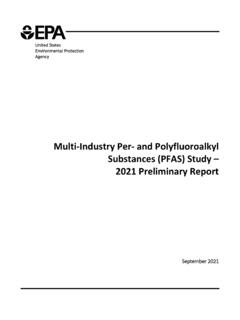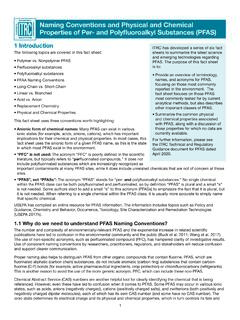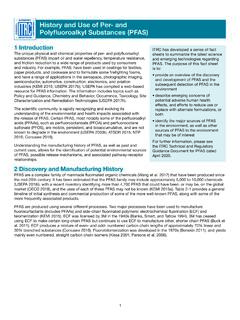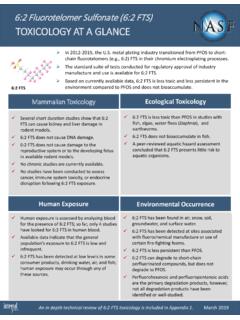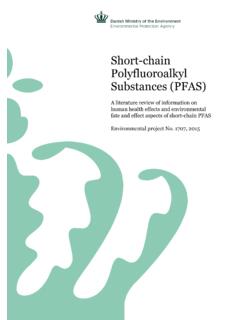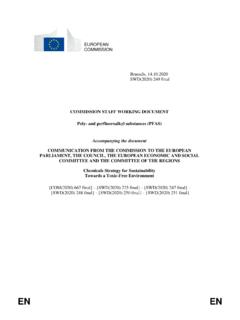Transcription of Method 533: Determination of Per- and Polyfluoroalkyl ...
1 Method 533: Determination OF PER- AND. Polyfluoroalkyl SUBSTANCES IN DRINKING WATER BY. ISOTOPE DILUTION ANION EXCHANGE SOLID PHASE. EXTRACTION AND LIQUID CHROMATOGRAPHY/TANDEM. MASS SPECTROMETRY. Technical questions concerning this analytical Method should be addressed to: Steven C. Wendelken, EPA, Office of Ground Water and Drinking Water, Standards and Risk Management Division, Technical Support Center, 26 W. Martin Luther King Dr. Cincinnati, OH 45268. Phone: (513) 569-7491. Questions concerning this document or policy should be addressed to: Office of Water (MS-140). EPA Document No. 815-B-19-020. EPA contract EP-C-17-014. November 2019. Authors Laura Rosenblum, , APTIM (Cincinnati, OH). Contractor's role did not include establishing Agency policy. Steven C. Wendelken, , EPA (Cincinnati, OH).
2 Acknowledgements Alan Zaffiro, APTIM (Cincinnati, OH). The following organizations completed a validation study in their laboratories using this Method , provided valuable feedback on the Method procedures and reviewed the draft Method manuscript: Babcock Laboratories, Inc. (Riverside, CA). Eurofins Eaton Analytical, LLC (South Bend, IN). Eurofins TestAmerica (Sacramento, CA). Merit Laboratories, Inc. (East Lansing, MI). Shimadzu Scientific Instruments (Columbia, MD). Thermo Fisher Scientific (Sunnyvale, CA). Weck Laboratories, Inc. (City of Industry, CA). Vogon Laboratory Services Ltd. (Cochrane, Alberta, Canada). Disclaimer This analytical Method may support a variety of monitoring applications, which include the analysis of multiple short - chain per- and Polyfluoroalkyl substances ( pfas ) that cannot be measured by Method This publication meets an agency commitment identified within the 2019 EPA pfas Action Plan.
3 Publication of the Method , in and of itself, does not establish a requirement, although the use of this Method may be specified by the EPA or a state through independent actions. Terms such as must or required, as used in this document, refer to procedures that are to be followed to conform with the Method . References to specific brands and catalog numbers are included only as examples and do not imply endorsement of the products. Such reference does not preclude the use of equivalent products from other vendors or suppliers. 533-i Table of Contents 1 Scope and 1. 2 Method Summary .. 2. 3 Definitions .. 3. 4 Interferences .. 5. 5 Safety .. 7. 6 Equipment and Supplies .. 8. 7 Reagents and Standards .. 10. 8 Sample Collection, Preservation, and Storage .. 16. 9 Quality Control .. 17. 10 Calibration and Standardization.
4 22. 11 Procedure .. 26. 12 Data Analysis and Calculations .. 29. 13 Method 31. 14 Pollution Prevention .. 31. 15 Waste Management .. 31. 16 References .. 31. 17 Tables, Figures and Method Performance Data .. 32. 533-ii Tables Table 1. HPLC Method Conditions .. 32. Table 2. ESI-MS Method Conditions .. 32. Table 3. Isotopically Labeled Isotope Performance Standards and Retention Times .. 33. Table 4. Isotope Dilution Analogues: RTs and Suggested Isotope Performance Standard References ..33. Table 5. Method Analytes, Retention Times and Suggested Isotope Dilution Analogue References ..34. Table 6. MS/MS Method Conditions .. 35. Table 7. LCMRL Results .. 37. Table 8. Precision and Accuracy Data for Reagent Water .. 38. Table 9. P&A in Reagent Water: Isotope Dilution Analogue Recovery Data .. 39. Table 10.
5 Precision and Accuracy Data for Finished Ground 40. Table 11. P&A in Finished Ground Water: Isotope Dilution Analogue Recovery 41. Table 12. Precision and Accuracy Data for a Surface Water Matrix .. 42. Table 13. P&A in Surface Water Matrix: Isotope Dilution Analogue Recovery 43. Table 14. Aqueous Sample Holding Time 44. Table 15. Extract Holding Time Data .. 45. Table 16. Initial Demonstration of Capability (IDC) Quality Control Requirements .. 46. Table 17. Ongoing Quality Control Requirements .. 46. Figures Figure 1. Example Chromatogram for Reagent Water Fortified with Method Analytes at 80 ng/L .. 48. 533-iii 1 Scope and Application This is a solid phase extraction (SPE) liquid chromatography-tandem mass spectrometry (LC-MS/MS). Method for the Determination of select per- and Polyfluoroalkyl substances ( pfas ) in drinking water.
6 Method 533 requires the use of MS/MS in Multiple Reaction Monitoring (MRM) mode to enhance selectivity. Accuracy and precision data have been generated in reagent water and drinking water for the compounds included in the Analyte List. This Method is intended for use by analysts skilled in the performance of solid phase extractions, the operation of LC-MS/MS instrumentation, and the interpretation of the associated data. Analyte List Analytea Abbreviation CASRN. 11-Chloroeicosafluoro-3-oxaundecane-1-su lfonic acid 11Cl-PF3 OUdS 763051-92-9. 9-Chlorohexadecafluoro-3-oxanonane-1-sul fonic acd 9Cl-PF3 ONS 756426-58-1. 4,8-Dioxa-3H-perfluorononanoic acid ADONA 919005-14-4. Hexafluoropropylene oxide dimer acid HFPO-DA 13252-13-6. Nonafluoro-3,6-dioxaheptanoic acid NFDHA 151772-58-6. Perfluorobutanoic acid PFBA 375-22-4.
7 Perfluorobutanesulfonic acid PFBS 375-73-5. 1H,1H, 2H, 2H-Perfluorodecane sulfonic acid 8:2 FTS 39108-34-4. Perfluorodecanoic acid PFDA 335-76-2. Perfluorododecanoic acid PFDoA 307-55-1. Perfluoro(2-ethoxyethane)sulfonic acid PFEESA 113507-82-7. Perfluoroheptanesulfonic acid PFHpS 375-92-8. Perfluoroheptanoic acid PFHpA 375-85-9. 1H,1H, 2H, 2H-Perfluorohexane sulfonic acid 4:2 FTS 757124-72-4. Perfluorohexanesulfonic acid PFHxS 355-46-4. Perfluorohexanoic acid PFHxA 307-24-4. Perfluoro-3-methoxypropanoic acid PFMPA 377-73-1. Perfluoro-4-methoxybutanoic acid PFMBA 863090-89-5. Perfluorononanoic acid PFNA 375-95-1. 1H,1H, 2H, 2H-Perfluorooctane sulfonic acid 6:2 FTS 27619-97-2. Perfluorooctanesulfonic acid PFOS 1763-23-1. Perfluorooctanoic acid PFOA 335-67-1. Perfluoropentanoic acid PFPeA 2706-90-3.
8 Perfluoropentanesulfonic acid PFPeS 2706-91-4. Perfluoroundecanoic acid PFUnA 2058-94-8. a. Some pfas are commercially available as ammonium, sodium, and potassium salts. This Method measures all forms of the analytes as anions while the identity of the counterion is inconsequential. Analytes may be purchased as acids or as any of the corresponding salts. 533-1. Detection of pfas Isomers Both branched and linear pfas isomers may be found in the environment. This Method includes procedures for summing the contribution of multiple isomers to the final reported concentration. In those cases where standard materials containing multiple isomers are commercially available, laboratories should obtain such standards for the Method analytes. Lowest Concentration Minimum Reporting Limits The lowest concentration minimum reporting level (LCMRL) is the lowest concentration for which the future recovery is predicted to fall between 50 and 150% with high confidence (99%).
9 Single-laboratory LCMRLs determined for the Method analytes during Method development are reported in Table 7. It should be noted that most of the LCMRL values determined during the second laboratory evaluation were lower than the values listed in Table 7. The values that a laboratory can obtain are dependent on the design and capability of the instrumentation used. The procedure used to determine the LCMRL is described ,2 Laboratories using this Method are not required to determine LCMRLs, but they must demonstrate that they are able to meet the minimum reporting level (MRL) (Sect. ) for each analyte per the procedure described in Section Method Flexibility The laboratory may select LC columns, LC conditions, and MS conditions different from those used to develop the Method . At a minimum, the isotope dilution standards and the isotope performance standards specified in the Method must be used, if available.
10 The laboratory may select the aqueous sample volume within the range of 100 250 mL that meets their objectives. During Method development, 250 mL aqueous samples were extracted using a 500 mg solid phase extraction (SPE). sorbent bed volume. The ratio of sorbent mass to aqueous sample volume may not be decreased. If a laboratory uses 100 mL aqueous samples, the sorbent mass must be at least 200 mg. Changes may not be made to sample preservation, the quality control (QC) requirements, or the extraction procedure. The chromatographic separation should minimize the number of compounds eluting within a retention window to obtain a sufficient number of scans across each peak. Instrumental sensitivity (or signal-to- noise) will decrease if too many compounds are permitted to elute within a retention time window.










